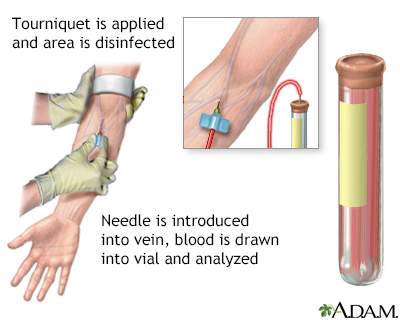Which of the following specimens has a phlebotomist appropriately prepared for transport?
A red-top tube that is being shipped after clotting for 15 minutes and being centrifuged
A tube containing serum that is being shipped after separation from a lavender-top tube
A tiger-top tube for bilirubin testing that is being shipped in a clear biohazard bag
A green-top tube for ammonia testing that is being shipped in an icy water mixture
The Correct Answer is D
Choice A Reason:
A red-top tube is used for serum determinations in chemistry and should be allowed to clot completely, typically for 30 minutes, before centrifugation. Shipping after only 15 minutes may result in incomplete clotting and potentially inaccurate test results.
Choice B Reason:
Serum should not be separated from a lavender-top tube, as this type of tube contains EDTA and is used for whole blood tests, not serum. This indicates a misunderstanding of the tube's purpose and could lead to compromised test results.
Choice C Reason:
A tiger-top tube, also known as a serum separator tube, is used for various chemistry tests. However, bilirubin is light-sensitive, and specimens for bilirubin testing should be protected from light, not shipped in a clear bag. This could lead to degradation of the bilirubin and inaccurate results.
Choice D Reason:
A green-top tube contains heparin and is used for plasma determinations. Ammonia testing requires the plasma to be placed on ice immediately after collection to inhibit the continued production of ammonia from red blood cells. Therefore, shipping in an icy water mixture is the correct procedure to ensure accurate ammonia levels.
In conclusion, the proper preparation and transport of blood specimens are crucial for the accuracy of laboratory tests. The green-top tube for ammonia testing, shipped in an icy water mixture, is the only option that follows the correct protocol for specimen handling and transport.
Nursing Test Bank
Naxlex Comprehensive Predictor Exams
Related Questions
Correct Answer is C
Explanation
Choice A reason:
Simply observing the site to see if the hematoma worsens is not an appropriate response. While monitoring the development of a hematoma is part of the process, it is not a proactive measure to address the immediate issue. The phlebotomist must take action to prevent further injury or complication.
Choice B reason:
Asking the patient to apply pressure may be part of the post-venipuncture care, especially after the needle has been removed, to aid in stopping any bleeding. However, this does not address the immediate concern of a developing hematoma during the draw.
Choice C reason:
Releasing the tourniquet and stopping the draw is the correct action to take when a hematoma is observed. This response is in line with the standard procedure for when a complication arises during venipuncture. Stopping the draw helps prevent further blood from pooling and exacerbating the hematoma.
Choice D reason:
While calling for a nurse and assessing the patient's condition is important, especially if the phlebotomist needs assistance or the patient shows signs of distress, it should not be the first action taken. The immediate response should be to address the hematoma by stopping the draw.

Correct Answer is A
Explanation
Choice A Reason:
The chain of custody form is crucial in the context of a toxicology drug screen for legal purposes. It is a document that records the sequence of custody, control, transfer, analysis, and disposition of physical and electronic evidence. It is particularly important in legal cases where the results of the toxicology screen can be used as evidence in court. The chain of custody ensures that the sample has been handled properly and that the integrity of the sample has been maintained throughout the testing process.
Choice B Reason:
A requisition form is used to request a specific test or service. While it is an essential document in the process of ordering a toxicology drug screen, it does not serve the same purpose as the chain of custody in terms of legal proceedings. The requisition form typically includes patient information, the tests ordered, and the reason for the test, but it does not track the handling of the sample.
Choice C Reason:
An encounter form, also known as a superbill, is used in medical billing to capture the services provided during a patient's visit. It includes information about the patient's diagnosis, the procedures performed, and the codes for billing purposes. However, it is not specifically related to the legal aspects of a toxicology drug screen.
Choice D Reason:
The CMS 1500 form is the standard claim form used by healthcare providers to bill Medicare and Medicaid services. It is also used by some private insurers and managed care plans. Like the encounter form, it is related to billing and not to the legal chain of custody required for a toxicology drug screen.
Whether you are a student looking to ace your exams or a practicing nurse seeking to enhance your expertise , our nursing education contents will empower you with the confidence and competence to make a difference in the lives of patients and become a respected leader in the healthcare field.
Visit Naxlex, invest in your future and unlock endless possibilities with our unparalleled nursing education contents today
Report Wrong Answer on the Current Question
Do you disagree with the answer? If yes, what is your expected answer? Explain.
Kindly be descriptive with the issue you are facing.
